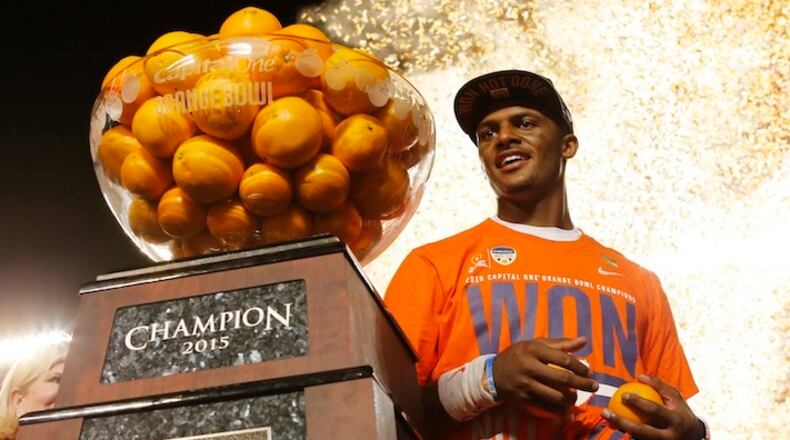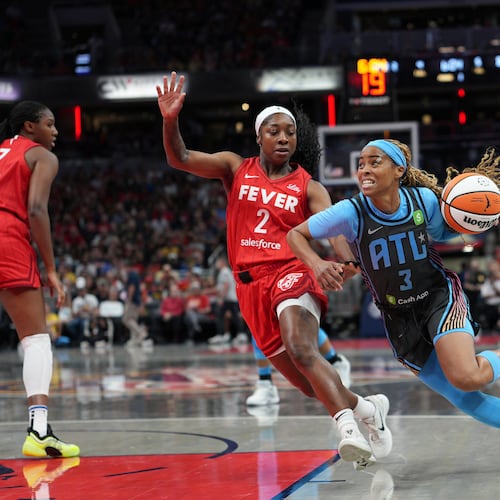College football needs to get its scheduling act together now that it has overhauled and downgraded the bowl system.
The attempt by conference commissioners to create a New Year's Eve destination date for the College Football Playoff semifinal games failed miserably. Television viewership plunged 45 percent for the Cotton Bowl and 34 percent for the Orange Bowl compared to semifinals a year ago, while numbers also collapsed for blowout Rose Bowl and Sugar Bowl non-playoff games New Year's Day.
It was generally accepted that the playoff format, now in its second season, might hurt traditional powerhouse bowls not designated as semifinals. That's why semifinals are rotated yearly between the six biggest bowls, a sharing of wealth and pain officials hope results in their playoff eventually rivaling the Super Bowl from a business and popularity standpoint.
Things looked great a year ago, with the semifinals debuting on New Year's Day. But that's because the Rose Bowl and Sugar Bowl, typically shown Jan. 1, were the semifinal hosts. This time, those bowls insisted on keeping their New Year's Day slots, which pushed the semifinals to New Year's Eve -- with disastrous consequences.
Fans were either working or prepping for New Year's Eve parties and didn't watch the semifinals. And then, they avoided the Rose Bowl and Sugar Bowl as well, handing both their worst TV numbers since 1999 as part of a 13 percent ratings decline overall for the six major Thursday and Friday contests.
So far, there are no plans to switch the semifinals beyond their New Year's Eve destinations in seven of the next 10 years. And that's too bad, since few fans seem pleased by this winter's bowl experience.
Part of it was all the blowouts, which can't be controlled.
But another factor likely compounding disappointment is all the slop fans endured to just to reach this point. Throughout December, they'd watched a bunch of .500 teams compete in alleged "bowl" games geared toward tourism cash grabs and easy TV ratings.
Twenty years ago, you had only 18 bowl games. Now, there are 40, played by 80 teams -- 62.5 percent of eligible schools -- meaning talent dilution at its all-time worst. Not to mention whacked-out-sounding bowl names, far-flung locales and questionable start times only a TV network with dead air to fill could love.
In fact, filling dead air is the biggest reason the dud bowls exist. And with half-decent TV viewership numbers, they aren't going away.
ESPN Events owns and operates 13 bowl games, including some of the worst offenders masquerading as a "reward" for mediocrity.
If we started a "Worst Bowl Game in America" list, the ESPN-owned Famous Idaho Potato Bowl would sit near the top. Despite existing for 19 years -- previously as the Humanitarian Bowl -- it drew only 18,876 fans to see traditional soccer power Akron defeat 6-6 Utah State on a blue field in Boise that matched the frigid temperatures.
And yet, due to our nation's college football obsession, it logged more than a million TV viewers -- 1,076,000 to be exact -- to beat ESPN's typical canned weekday afternoon programming.
Some made-for-TV bowls have actually seen significant viewership increases.
Take the Popeyes Bahamas Bowl, which would rival Boise for "Worst Bowl Game in America" if actually played in America. Western Michigan taking down Middle Tennessee State in a foreign country's partially filled 15,000-seat soccer stadium doesn't exactly scream postseason football and makes this another ESPN prop-up job. But prop it up the network did, drawing 2.1 million viewers -- 43 percent above last year's inaugural game.
And then, there's the bowl that featured our very own Washington Huskies.
The best thing about the Zaxby's Heart of Dallas Bowl was it had thousands of Washingtonians looking up the name of an upstart chicken franchise that doesn't operate within 500 miles of our state. Even deceptive TV camera angles couldn't hide that only 20,229 fans showed up to the 92,100-capacity Cotton Bowl Stadium.
Still, the Huskies' win over Southern Miss drew 2.6 million viewers on ESPN, up 12 percent over last year's game. Turns out, the "heart" of this bowl lies well beyond Dallas.
And out-of-town living rooms is the only place these faux bowls will keep finding limited success. As long as the NCAA cheapens its postseason with 6-6 and even 5-7 teams, TV networks will seek easy ratings from bowls played in largely empty venues.
That's great if booster junkets and some bonus ratings candy is the goal.
But there's supposed to be a bigger payoff this was all building to: Super Bowl-type ratings and revenues from meaningful games that aren't TV filler.
That part isn't happening.
It's one thing for college football to push limits by making fans endure weeks of phony bowls to grab some loose change. It's quite another to push luck by greedily pretending traditional New Year's Day bowls still mean enough to keep coveted slots. And we now know it was pushing way too far to try to commandeer New Year's Eve for a playoff cash grab.
Something has to give, because no one's buying it. Unless that changes, you've cheapened the entire bowl experience for nothing.
About the Author
Keep Reading
The Latest
Featured


